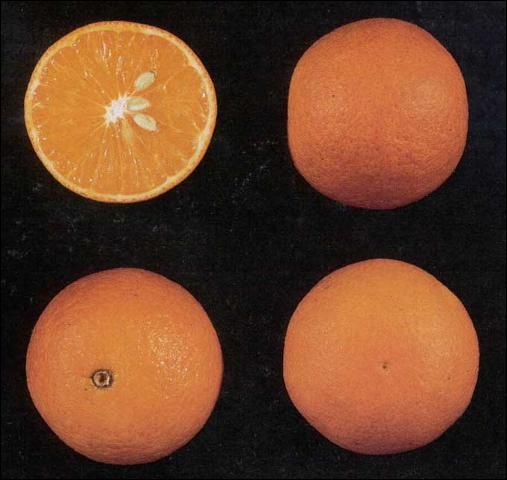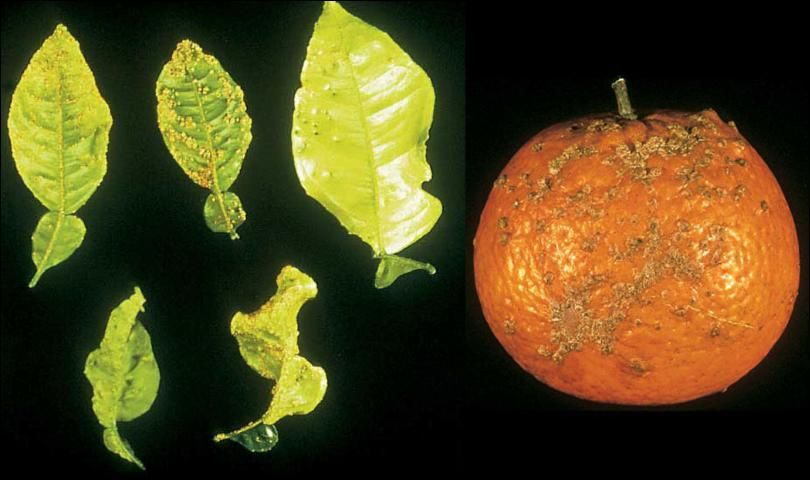While the Page (Figure 1) is considered an orange by some, it is actually a hybrid of Minneola tangelo and Clementine mandarin. Since Minneola is a grapefruit-tangerine hybrid, Page is actually 3/4 tangerine and 1/4 grapefruit. The cultivar was released in 1963 and came from a cross made in 1942 by Gardner and Bellows of the United States Department of Agriculture facility in Orlando.

Credit: UF/IFAS
Page is an early-ripening, high quality cultivar that showed considerable promise in early trials but has not fared well in commercial cultivation due to several problems that will be brought out later.
Fruit Characteristics
Fruit size of Page is often a problem. Trees tend to produce fruit of unacceptably small size and the reasons and solutions to the problem remain undiscovered. Marketable fruit are medium sized, about 2–2½ inches in diameter. The rind is medium-thin, leathery, but easy to peel with good color. The shape is round to slightly oblong as is typical of a sweet orange. Seed numbers vary from very few in solid plantings with up to as many as 25 in mixed plantings where cross-pollination readily occurs.
Page matures early in most years (October) and holds on the tree very well with some fruit harvested as late as February. The fruit (and the foliage) is susceptible to scab fungus disease (Figure 2). For more information on this disease see Florida Citrus Production Guide: Citrus Scab.

Credit: UF/IFAS
Tree Characteristics
Page trees are moderately vigorous with an upright growth habit. Branches are nearly thornless and may assume a drooping appearance under a heavy crop load. The tree is relatively cold hardy and should be interplanted with other pollenizer varieties to ensure good fruit set and fruit size. Trees appear quite productive but even under the best conditions small fruit size can be a problem.
Since Page has not been widely grown, not a great deal is known about rootstock selection. However, one would likely want to select a rootstock such as Carrizo which could promote fruit size and quality where possible.
Cultivation
Page should behave like any other citrus tree in commercial cultivation. Some production problems have limited commercial production, but the variety is an excellent tree for the home gardener due to the high quality of the fruit and long harvest periods.
- Page is plagued by small fruit size, often setting large crops of very small fruit even under ideal conditions.
- Page should receive optimum care and be interplanted with pollenizer varieties such as Lee, Orlando, or Temple to minimize fruit size problems.
- Susceptibility to scab fungus diseases will necessitate a rigid spray schedule, especially during spring months.
More Information
Hearn, C.J. and P.C. Reece. 1967. "Pollination Needs of Page, Lee, Nova and Robinson Citrus Hybrids." Citrus Industry Magazine. 48(4):19,23.
Hearn, C.J., P.C. Reece and R. Fenton. 1968. "Effects of Pollen Source on Fruit Characteristics and Set of Four Citrus Hybrids." Proc. Fla. State Hort. Soc. 81:94–97.
Hearn, C. J. and D. J. Hutchison. 1977. "The Performance of Robinson and Page Citrus Hybrids on 10 Rootstocks." Proc. Fla. State Hort. Soc. 90:44–47.
Jackson, Larry K. and Frederick S. Davies. 1999. Citrus Growing in Florida, Fourth Edition. University Press of Florida, Gainesville, FL. p. 98.
Saunt, James. 2000. Citrus Varieties of the World. Sinclair International Limited, Norwich, England. p. 84.
Tucker, D.P.H., S.H. Futch, F.G. Gmitter, and M.C. Kesinger. 1998. Florida Citrus Varieties. SP-102. UF/IFAS Extension. p. 41.